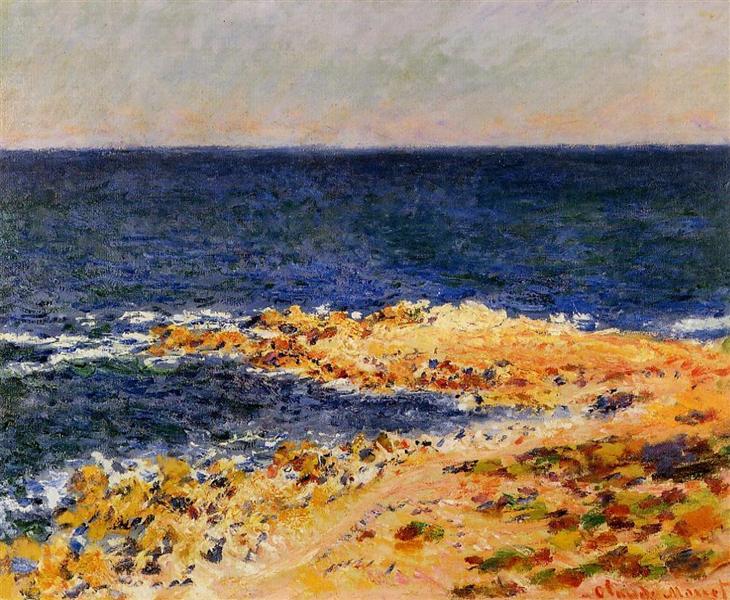Beschreibung
Claude Monet's painting "The Big Blue at Antibes" painted in 1888 stands as a vivid testament to the artist's mastery in the use of color and light, a hallmark of the Impressionist movement he helped establish. In this work, Monet captures the essence of the Mediterranean Sea and the light that bathes the coast of Antibes, a place that became an important refuge for many artists and intellectuals of his time. The work presents a wide view of the water, stretching to the horizon, posing a dialogue between the vibrant blue color of the sea and the sky, creating a symphony of nuances where various shades intertwine.
The composition is characterized by simplification and reduction of detail in the depiction, allowing the audience to focus on the interplay of colors and shapes. Monet captures the movement of water with loose, dynamic brushstrokes that suggest both the calm and the ebb and flow of the waves. The depth of the blue intensifies as it moves toward the horizon, providing a sense of depth that invites the viewer to immerse themselves in the scene. This loose brushstroke technique is one of the most recognizable features of Monet's work, who preferred to evoke the feeling of a specific moment, rather than an exact representation.
In the piece, a small boat is seen drifting, its sparse presence complementing the sense of vastness of the ocean. This subtle inclusion of the human figure, while not focusing on any particular character, suggests a connection between humans and nature, a recurring theme in Monet's work. The boat is transformed into an element to emphasize the immensity of the landscape, an approach that Monet adopted in many of his works, where the human is in constant dialogue with the natural environment.
Monet painted The Large Blue at Antibes during a period when he was exploring the light and atmosphere of the Mediterranean, which allowed him to experiment with the effects of light on the surface of the water. His colour choices are bold, with an emphasis on blues, turquoises and whites that capture the luminosity of the location, contrasting with the darker tones of the background. The use of these vibrant colours is a reflection of the Impressionist style, which emphasises capturing a specific moment under the changing influence of light.
Antibes, one of the towns Monet visited during his stay on the French Riviera, not only inspired the work, but also symbolized a period in his career marked by exploration and experimentation with new techniques and concepts. The open sea and clear skies became recurring themes in his work, and The Big Blue at Antibes ennobles this transition towards greater freedom of expression.
In conclusion, The Big Blue at Antibes is a stunning display of Monet's ability to evoke emotion and sensation through light and color. The profound interconnection between humans and nature, the simplicity of form, and the ability to capture an ephemeral moment in time are aspects that elevate this work beyond a mere landscape, making it a meditation on the beauty and tranquility of the natural environment. This painting stands not only as an artistic achievement, but as a visual refuge that transports the viewer to the serenity of the Mediterranean Sea, where the relationship between color, light, and form merge into a sublime experience.
KUADROS ©, a famous painting on your wall.
Hand-made oil painting reproductions, with the quality of professional artists and the distinctive seal of KUADROS ©.
Painting reproduction service with satisfaction guarantee. If you are not completely satisfied with the replica of your painting, we will refund 100% of your money.

